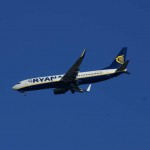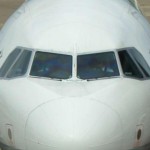Nearly precisely to the day, 50 years ago, a Tupolev-104A jet plane, in the colours of Czechoslovak Airlines, took off from Ruzyně Airport for its first scheduled flight to Moscow. It was a historic moment that carried the Airline into the jet age. The Prague – Moscow route also became the first entirely jet-operated route in the world.
“In 1957, Czechoslovak Airlines reached the absolute peak of world aviation technology and again showed its back to the competition, as it has many times in its 85-year history. The fact that our predecessors were among the first in the world to use jets for civilian purposes is a great inspiration and challenge for us at this time, when we are again bringing Czech Airlines to prosperity, after the errors of previous years. I trust that we will soon be able to leave a positive mark in history, of a similar significance,” says Czech Airlines’ Vice-President for Marketing and Product Development, Petr Pištělák.
“Civilian jet aircraft launched not only a new stage of air carriage, but also major changes in the development of airport infrastructure here at Ruzyně, as well as at every other airport that received these aircraft,” said Petr Hloušek, Prague Airport’s Director for Operations Development and Administration, adding: “The technical parameters of those aircraft differed: on one hand, they had more powerful engines and achieved high speeds, and, on the other hand, jet engines have slower response times. Hence, they required longer take-off and landing runways, equipped with modern airport safety systems.”
The inclusion of Tupolevs into Czechoslovak Airlines’ fleet also posed a great challenge for pilots and technicians, who had to learn to operate and service a much more powerful and complex aircraft than the then most broadly used types of aircraft, with piston engines.
“Pilots, especially captains, learned to pilot them relatively quickly and perfected the landing manoeuvre at lower speeds, making most landings without the use of a breaking parachute,” relates Zdeněk Sedláček, a former Tupolev-104A captain, adding: “In their time, 50 years ago, Czechoslovak Airlines’ crews and technicians were highly professionally skilled, and hence the Tu-104A aircraft were respected at all airports. The first Czechoslovak Airlines turbine aircraft was especially valued for its trouble-free operation, reliability, and the related on-time record,” says Zdeněk Sedláček.
Czechoslovak Airlines’ specialists thus showed indisputable qualities and professionalism, which were always typical and broadly recognised features of the Airline. Its previous technical cooperation with Aeroflot continues successfully today in the global SkyTeam Alliance.
At its time, the Tupolev-104A represented a revolutionary change in commercial flying. Just a few interesting facts:
• The cruising speed of the Tupolev-104A ranged around 1,000 km/h. The formerly commonly used piston type Avia Av-14 cruised at 320 km/h;
• The maximum altitude that the Tu-104A aircraft were able to reach was 12,000 metres, as opposed to the 6,900 of the Avia Av-14, normally deployed on Czechoslovak Airlines routes. Flying at high altitudes is comfortable for passengers, as the aircraft is less exposed to turbulence than at lower flight levels;
• The Tupolev-104A was historically the first aircraft of Czechoslovak Airlines to cross the equator (14 August 1960 on the route to Djakarta, Indonesia)
On the occasion of this significant jubilee of the event, Czech Airlines, Prague Airport, the Ministry of Transport, and Air Navigation Services have organised a commemorative gathering for Friday, 7 December. At 10:00 a.m., 30 former pilots and technicians who worked with the Tupolev 104A will be honoured with a commemorative diploma, coin, and an award at the Czech Airlines administrative and operational centre. The awardees will then move to the Prague Airport Conference Hall, where the commemorative event will continue.
The History of the Tupolev 104A’s Services with Czechoslovak Airlines
To start off, we should note that the famous Tupolev-104 was not the first commercial jet aircraft in the world – that was the British De Havilland DH 106 Comet, deployed in regular operation by BOAC, on 2 May 1952, on the London-Johannesburg route. The fate of this model was, however, relatively complicated: after several accidents and the detection of an engineering defect, some versions of the aircraft were withdrawn from operation by civilian operators.
The Tupolev-104 originated from a modification of the first Soviet strategic jet bomber, the Tu-16. For several years, this obviously elegant aircraft, with pronounced arrow-shaped wings, a slender fuselage, and tall landing gear, became a hard-to-miss landmark of European, Asian, as well as American airports, drawing great attention from pilots, technicians, journalists, and passengers alike. The Tupolev-104 was a revolutionary construction. All of a sudden, commercial flying rose to the altitude of up to 12,000 metres, which brings financial advantages as well as greater comfort for passengers, who are not exposed to such a pronounced impact of turbulence, as when travelling at lower altitudes. The maximum speed of the Tupolev was slightly over 1,000 km/h, whereas regular piston-type engine aircraft, such as the Ilyushin 14, flew at a maximum speed of just over 400 km per hour.
The first version of the Tu-104 carried 50 passengers, seated in a – for that era – relatively luxurious and comfortable interior, which was designed by the wife of the main engineer,
A. N. Tupolev. Czechoslovak Airlines, however, modified the posh interior of its Tupolevs, according to the design of the architect Filsak. The modification was carried out by the domestic aviation-technology producer Avia Letňany, in Hangar E at Ruzyně Airport. Soon, it became evident that, given the high fuel consumption of jet engines, the carriage capacity of the aircraft needed to be expanded, so that the higher income from tickets would cover the high costs of operation, as jet engine fuel consumption was several times higher than that of piston engines. This gave rise to the Tu-104A version for 70 passengers; however, the Tupolev’s development did not stop there. Over time, several other versions were created.
Ruzyně Airport in Prague saw its first Tu-104 on 15 June 1956, when Aeroflot’s jet landed there. This practical demonstration of the aircraft contributed to the decision to purchase a Tupolev 104A for Czechoslovak Airlines, which then became the only foreign user of that type of aircraft.
Over time, the Airline included six Tu-104s in its fleet. When the Tupolev 104A was put into operation, Czechoslovak Airlines’ specialists had to design and execute certain modifications on the aircraft. These included a modification of the piloting-navigation system and the passenger cabin, and the equipping of the aircraft with individual and collective emergency equipment, i.e., life vests, inflatable rafts, and other equipment, to bring it into line with the requirements of the International Civil Aviation Organisation (ICAO). Czechoslovak Airlines’ specialists also had to create new documentation for the aircraft, compliant with ICAO requirements. For successfully coping with these tasks, Czechoslovak Airlines was admired by its partners from Aeroflot, as well as by other airlines and aviation experts.
With the Tu, Czechoslovak Airlines began flying to the Middle East, and Bombay, India. On this flight, the planes crossed the peaks of the Pamir and Himalayas. On 14 August 1960, the Tu-104A became the first plane of Czechoslovak Airlines ever to cross the equator, while flying on the route from Prague to Djakarta, 13,944 kilometres long. The introduction of the Tupolev into operation brought Czechoslovak Airlines a 50% year-on-year increase in the number of passengers carried, in the very first year of operations. Aside from scheduled flights, Czechoslovak Airlines’ Tupolevs were also used for charter carriage. For example, in 1965, Cambodian pilgrims flew on board of a Czechoslovak Airlines Tu, from the metropolis of Phnom Penh to Jeddah in Saudi Arabia.
The first commercial jet aircraft served Czechoslovak Airlines until 1974. The last flight was flown by the crew of Captain Stanislav Epstein, co-pilot Boris Rýdl, navigator Marcel Drábek, and on-board mechanic Jan Fíla, on the Prague-Ostrava-Prague route, on 25 April 1974. When it landed at Ruzyně, less than three hours remained to the end of the Tupolev OK-NDF’s flight life. Subsequently, the aircraft was used as a film prop, as was the second aircraft which at that time still flew in the Czechoslovak Airlines’ fleet, the OK-LDC. That was, in the end, sold to Toužim, near Carlsbad, as a club-room. The OK-NDF ended up near the Spartakiad Stadium in Olomouc, as a restaurant and bar.
Today, a Czechoslovak Airlines Tupolev-104A can be seen in the aviation museum of the Military Historical Institute in Prague-Kbely. This is the very first Tu aircraft used by Czechoslovak Airlines, with the registration mark OK-LDA, which launched the operation of this type on the Moscow route. The aircraft was placed in the museum after its last flight, on 14 September 1973. Before the start of the 2007 season, the aircraft was restored, and today it is displayed in a new location. It can be viewed from May until the end of October, from 10:00 a.m. until 6:00 p.m.






